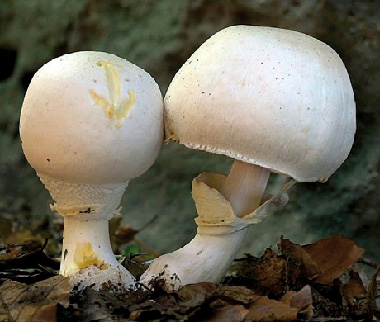Yellow–staining mushroom: Red Data Book of Armenia

Category. NT – Near threatened.
Brief description. Cap is 2–12 cm across, white, whitish, grey with darker colour in the center. When touched it gets yellow or yellowish– orange colouring. It is glabrous, smooth, velvety, shiny, thick fleshy, bell–shaped, spherical, eventually extended, flat in the centre, sometimes cracked with plicate margins and with partial remnants of the volva. Flesh is white, chrome–yellow in the stipe base and bright yellow when cut, with unpleasant smell of carbolic acid. Gills are whitish, pink, dark brown, almost black. Stipe is 5–10 x 1–4 cm having the colour of the cap, glabrous, yellow at the base, convex, wide, whitish with yellow margined ring. Spore print is dark brown. Spores are 5,5–6,5 x 3,5–5 µm, brown, globose–ovoid, smooth.
Distribution. Generally in America, Europe, Africa, Australia, Southern Caucasus (Azerbaijan, Georgia, Armenia). It is wide spread in some European countries. In Armenia the unique examples of this species are found in Aragats floristic region – in the surroundings of lake Sevan and in Yerevan floristic region – in "Tsitsernakaberd" park.
Ecological, biological and phytocenological peculiarities. It can be met on the soil, in alpine meadows, pastures, in parks, on the altitude of 1000–3500 m above sea level in June and July. Saprotrophic fungi on humus. Poisonous.
Main factors of endangering. Limited distribution, degradation and breakdown of ecosystems, expand of pastures.
Nature conservation measures. It is necessary to carry out monitoring of the population state.
Suggestions
 The Ministry of Environment sent a letter international partners to draw their attention to the real danger of environmental disasters as a result of Azerbaijan's large-scale aggression towards the territory of Armenia
The Ministry of Environment sent a letter international partners to draw their attention to the real danger of environmental disasters as a result of Azerbaijan's large-scale aggression towards the territory of Armenia
 Vicia pisiformis: Red Data Book of Armenia
Vicia pisiformis: Red Data Book of Armenia
 Vavilovia formosa: Red Data Book of Armenia
Vavilovia formosa: Red Data Book of Armenia
 Trigonella capitata: Red Data Book of Armenia
Trigonella capitata: Red Data Book of Armenia
 Trigonella astroides: Red Data Book of Armenia
Trigonella astroides: Red Data Book of Armenia












